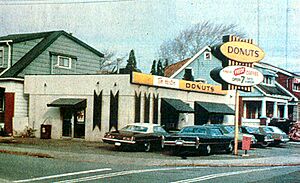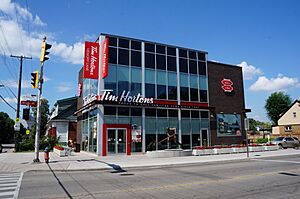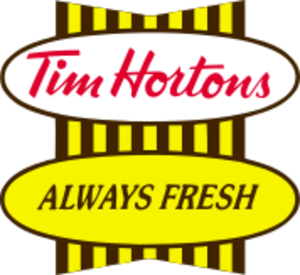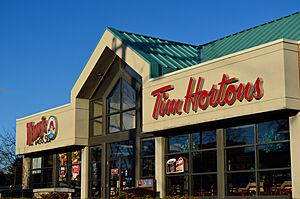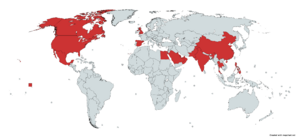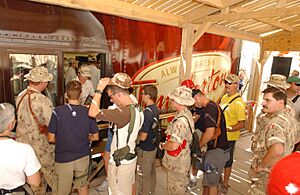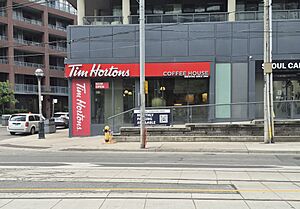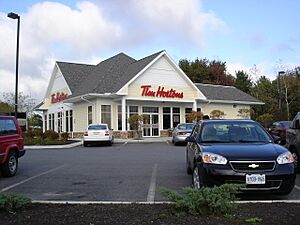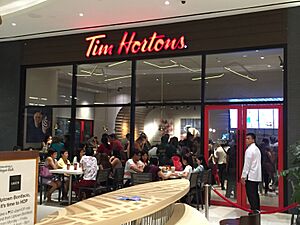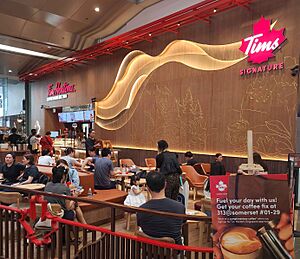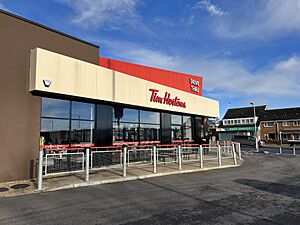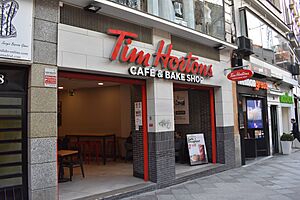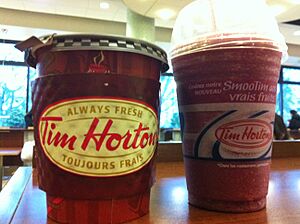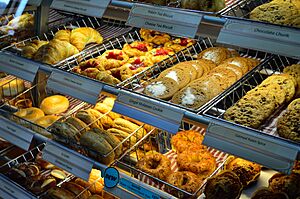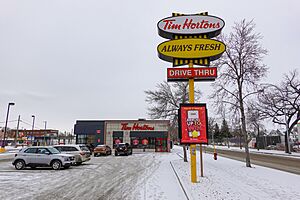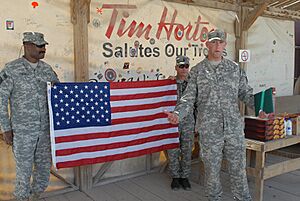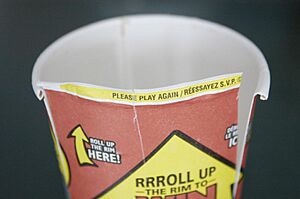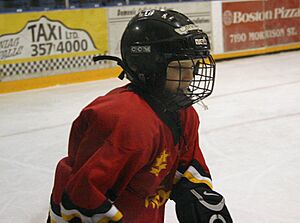Tim Hortons facts for kids
 |
|
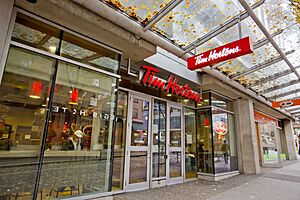
Tim Hortons in Vancouver
|
|
|
Formerly
|
Tim Horton Donuts Tim Donuts Limited The TDL Group |
|---|---|
| Subsidiary | |
| Industry | Restaurants |
| Founded | May 17, 1964 Hamilton, Ontario, Canada |
| Founders |
|
| Headquarters | Toronto, Ontario, Canada |
|
Number of locations
|
5,701 restaurants (September 30, 2023) |
|
Areas served
|
List
|
|
Key people
|
J. Patrick Doyle (Executive Chairman, RBI) Joshua Kobza (CEO, RBI) Axel Schwan (president, Tim Hortons Canada & U.S.) |
| Products |
List
|
| Total assets | |
| Parent | Restaurant Brands International |
Tim Hortons Inc. is a well-known Canadian coffee and restaurant chain. People often call it Tim's, Timmies, or Timmy's. Its main office is in Toronto, Canada. The chain serves coffee, donuts, sandwiches, breakfast items, and other fast food. It is Canada's largest quick-service restaurant chain. As of September 2023, Tim Hortons had 5,701 restaurants in 14 countries around the world.
The company started in 1964 in Hamilton, Ontario, Canada. It was founded by Tim Horton, a famous Canadian ice hockey player (1930–1974), and Jim Charade (1934–2009). In 1967, Horton partnered with an investor named Ron Joyce. After Horton passed away in 1974, Joyce took over and helped the chain grow into a huge business. Jim Charade left the company in 1966. In 1995, Tim Hortons joined with The Wendy's Company, another restaurant chain. They operated together until 2006. Later, in 2014, Tim Hortons merged with Burger King. Both chains became part of a larger company called Restaurant Brands International.
Contents
History of Tim Hortons
How Tim Hortons Started: 1964–1989
The business was started by Tim Horton, a professional ice hockey player. He played in the National Hockey League from 1949 until he died in a car crash in 1974. The very first Tim Horton restaurant was in North Bay, Ontario, and it actually sold hamburgers!
The first donut shop opened on May 17, 1964, in Hamilton, Ontario. It was called "Tim Horton Donuts." Later, the name became "Tim Horton's" and then "Tim Hortons" without the apostrophe.
Soon after opening, Tim Horton met Ron Joyce, who used to be a police officer. In 1965, Joyce took over the first donut shop. By 1967, they had opened two more stores and became full partners. When Tim Horton died in 1974, Ron Joyce bought his family's share for $1 million. Joyce then became the sole owner of the 40 existing stores. He quickly expanded the chain, adding more locations and new food items. The 500th store opened in 1991.
Joyce's fast growth of the business changed the coffee and donut market in Canada. Many smaller donut shops closed down. Canada soon had more donut shops per person than any other country.
Changes and Growth: 1990–2002
The company was first called Tim Donut Limited. By the 1990s, its name changed to The TDL Group Ltd. This change was made to show that the company was selling more than just donuts. They wanted to offer a wider variety of food as people's tastes changed.
Some older Tim Hortons signs still have an apostrophe in the name ("Tim Horton's"). However, the official name has been "Tim Hortons" without an apostrophe for many years. The company removed the apostrophe in 1993. This was partly because of language laws in Quebec, which made it easier to have one common sign across Canada.
Joining with Wendy's
In 1992, Daniel P. Murphy, who owned Tim Hortons and Wendy's restaurants in Prince Edward Island, decided to open both in the same building. Ron Joyce and Wendy's chairman Dave Thomas met at the opening of this "combo store." Because this idea was successful, Wendy's International, Inc. bought Tim Hortons' parent company, TDL Group, on August 8, 1995. They operated together until 2009.
Many people talked about this sale in the news. Some felt that a "great Canadian icon" was being sold to an American company.
Becoming Independent Again: 2002–2006
Tim Hortons stores grew very quickly. They eventually became Canada's largest food service company, even bigger than McDonald's. By 2005, Tim Hortons had twice as many locations in Canada as McDonald's. By 2002, their total sales also passed McDonald's sales in Canada. In 2005, Tim Hortons made up 22.6% of all fast-food money earned in Canada.
Because of pressure from big investors, Wendy's announced in late 2005 that it would sell some of its Tim Hortons shares. This sale happened on March 24, 2006. Wendy's then sold all its remaining shares by the end of 2006. Wendy's said they made this choice because the two chains were competing more, and Tim Hortons was strong enough on its own.
Shares of Tim Hortons began trading on March 24, 2006, at CA$27 per share. This raised over $700 million on the first day. On September 24, Wendy's gave its remaining shares of Tim Hortons to its own shareholders. On the same day, Tim Hortons was added to Canada's main stock market index, the S&P/TSX Composite Index.
By March 2006, Tim Hortons controlled 76% of the Canadian market for baked goods. They also held 62% of the Canadian coffee market. Starbucks was second, with 7%.
Becoming a Canadian Company Again: 2007–2013
On June 29, 2009, Tim Hortons Inc. announced a plan to become a new public company based in Canada. This change was mainly for tax reasons. On September 28, 2009, Tim Hortons Inc. officially became a Canadian public company.
In November 2010, Tim Hortons started accepting Interac debit payments in most of its stores. They had already started accepting Mastercard in 2007. The company often said they waited to accept more electronic payments to keep service fast. In 2012, Tim Hortons began accepting Visa cards, and in 2013, they started taking American Express cards.
By late 2013, Tim Hortons had 4,350 cafes worldwide. About 3,500 were in Canada, 817 in the U.S., and 33 in the GCC countries.
Joining with Burger King: 2014
On August 24, 2014, the American fast-food chain Burger King announced it was talking about merging with Tim Hortons Inc. This big merger, worth about $18 billion, would create a new company based in Canada. A Tim Hortons representative said this merger would help Tim Hortons grow internationally by using Burger King's resources. Both chains would still operate separately. News of this plan made Tim Hortons' shares go up by 28 percent.
On August 25, 2014, Burger King officially confirmed it would buy Tim Hortons Inc. for CA$12.5 billion (US$11.4 billion). The new company would be based in Oakville, Canada. Burger King's CEO, Daniel Schwartz, became the CEO of the new company. This deal created the third-largest fast-food restaurant company in the world. On October 28, 2014, Canada's Competition Bureau approved the deal.
Former CEO Marc Caira said the purchase would help Tim Hortons bring its "iconic Canadian brand to a new global customer base." On December 4, 2014, the Canadian government approved the deal. The two companies agreed to keep their operations separate, maintain many jobs at the Oakville headquarters, and ensure Canadians made up at least 50% of Tim Hortons' board. Tim Hortons shareholders approved the merger on December 9, 2014. The two chains merged under the new parent company, Restaurant Brands International (RBI), which started trading on December 15, 2014.
Recent Years: 2015–Present
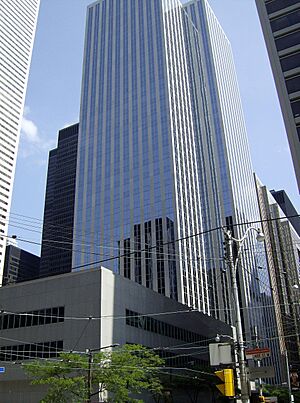
In May 2015, Tim Hortons announced it was closing its U.S. headquarters in Dublin, Ohio. In April 2018, Tim Hortons announced they would move their main office and its 400 employees to the Exchange Tower in downtown Toronto.
In October 2018, Tim Hortons started putting in self-serve kiosks at some locations in Ontario. By February 2019, these self-serve kiosks were being installed across Canada.
In November 2021, Tim Hortons started a special promotion with Toronto singer Justin Bieber. This included limited edition "Tim Biebs" Timbits and special merchandise.
Tim Hortons is also the main sponsor of Forge FC, a Canadian professional soccer club. This sponsorship shows Tim Hortons' support for Canadian sports, especially soccer, which is becoming very popular.
In 2024, to celebrate the brand's 60th anniversary, a musical called The Last Timbit was created and performed in Toronto.
Locations Around the World
As of December 31, 2018, Tim Hortons had 4,846 restaurants in 14 countries. This included 3,802 in Canada, 807 in the United States, 60 in Mexico, 29 in the Middle East, and 25 in the UK. As of August 2024, Tim Hortons has 5,702 restaurants globally.
Tim Hortons has also had locations on military bases. This included a special outlet in Kandahar, Afghanistan, which was mainly for Canadian and allied military personnel. There were also outlets at military bases in the U.S. and Latvia.
North America
Tim Hortons first started in Ontario and Atlantic Canada. But the chain has grown into Quebec and western Canada. Its location in Pond Inlet, Nunavut, is the northernmost store as of 2023.
Tim Hortons also has locations on Canadian and American university campuses. These include Brock University, York University, and the University of British Columbia.
In March 2010, Tim Hortons announced plans to open many new stores by 2013. This included 600 new stores in Canada and 300 new stores in the U.S. They also planned to open stores in places like hospitals, universities, and airports.
In 2010, Tim Hortons opened its northernmost locations at NorthMart stores in Iqaluit, Nunavut. This meant Tim Hortons now had a presence in every province and territory of Canada.
In December 2011, Tim Hortons opened its 4,000th restaurant. In 2012, Tim Hortons Inc. reported total revenues of $3.12 billion (CDN).
United States
The first U.S. stores opened in Florida in 1981 but closed later.
In 1984, the chain returned to the U.S. with a location in Tonawanda, New York. Starting in the mid-1990s, Tim Hortons began expanding in the U.S. by taking over former fast-food locations. For example, they bought former Rax and Hardee's restaurants and turned them into Tim Hortons. They also acquired 42 Bess Eaton coffee and donut restaurants in New England.
In July 2009, Tim Hortons opened stores in New York City at former Dunkin' Donuts locations. One of these stores is at Madison Square Garden, where Tim Horton played hockey. In November 2010, Tim Hortons announced it was closing 36 stores in the northeastern United States. This was due to strong competition from other coffee chains like Dunkin' Donuts.
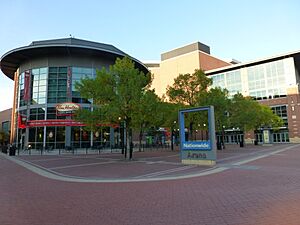
In 2010, Tim Hortons opened two small kiosks at a sports arena in Pittsburgh. This was a test for possibly expanding into the city. Tim Hortons later opened full-service locations in Pittsburgh in July 2012.
As of 2012, the company had expanded across many U.S. states, including Michigan, New York, Ohio, and Pennsylvania.
On January 7, 2014, Tim Hortons opened a kiosk in an arena in Glendale, Arizona. This was the first Tim Hortons in Arizona.
In 2020, Tim Hortons partnered with Bolla Market to open stores inside gas stations across Long Island, New York.
In 2022, Tim Hortons announced plans to expand into Georgia and Texas. They planned to open over 20 new stores in areas like Atlanta, Georgia, and Houston, Texas, over the next five years. On December 22, 2024, Tim Hortons opened its first location in Austin, Texas.
Cayman Islands
On April 4, 2023, Tim Hortons announced a new location in Prospect, Grand Cayman. This was the first Tim Hortons in the Caribbean. The store opened on October 12, 2024.
Asia
Tim Hortons began expanding in Asia in 2017. The first Southeast Asian branch opened in the Philippines on February 28, 2017, at Uptown Mall in Bonifacio Global City. As of December 2023, there are 52 locations in the Philippines.
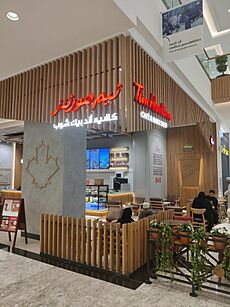
Through a partnership, Tim Hortons entered the United Arab Emirates in 2011. The first opening was in September 2011. As of December 2013, Tim Hortons had nineteen stores in the United Arab Emirates, two in Oman, and two in Saudi Arabia. They plan to open many more stores in the Persian Gulf area.
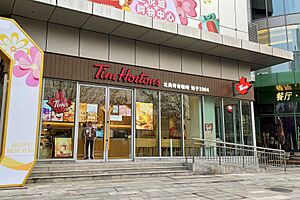
In July 2018, Tim Hortons announced they would open 1,500 stores in China. The first one opened on February 26, 2019, in Huangpu, Shanghai. By December 31, 2024, there were 1,022 stores across 82 cities in China.
The first Tim Hortons in Thailand opened on January 18, 2020, in Bangkok. As of January 2021, there are 10 locations there.
The first two Tim Hortons locations in India opened on August 11, 2022, in New Delhi and Gurugram.
On February 11, 2023, Tim Hortons opened four locations in Pakistan. In January 2024, another store opened in Islamabad.
In 2023, a Japanese company announced plans to open Tim Hortons in Singapore and Malaysia. The Singapore location officially opened on November 17, 2023. On August 30, 2024, Tim Hortons opened its first "Tim's Signatures" store in Singapore, offering more special coffee options. As of November 2024, Singapore has 11 Tim Hortons outlets.
Tim Hortons' first Malaysian store opened in August 2024.
In May 2023, Tim Hortons announced plans to expand into South Korea. As of October 2024, Tim Hortons has 13 stores in South Korea.
Europe
United Kingdom and Ireland
Tim Hortons products have been available in Ireland and the United Kingdom at some Spar stores and Tesco supermarkets since 2006.
In 2016, Tim Hortons announced they would open stores in the United Kingdom starting in 2017. Glasgow saw the first UK store open on June 2, 2017. By January 2023, there were 73 locations in the UK.
Ireland's first Tim Hortons opened in Limerick in 2022.
Spain
In December 2017, Tim Hortons opened two stores in Madrid, Spain. They later opened another in Pozuelo de Alarcón. The menu in Spain also includes typical Spanish drinks.
Andorra
There is a Tim Hortons shop in El Pas de la Casa, Andorra. It is listed on the Spanish Tim Hortons website.
Tim Hortons Menu
Tim Hortons' first stores only sold two things: coffee and donuts. Now, the menu has many other baked goods, like bagels. Tim Hortons sells one out of every two bagels in the Canadian food service industry. You can find nutritional information for most menu items online.
Most Tim Hortons locations have the same menu items. However, prices might be a little different because it's a franchise. The cost can vary depending on the owner and the province where the store is located.
Coffee and Drinks
Tim Hortons sells coffee, tea, hot chocolate, and soft drinks. In the mid-1990s, they started offering special drinks like flavored cappuccinos, iced cappuccinos, and iced coffee.
Even though they added more food around 2009, coffee sales were still a huge part of their business. In 2009, over 60% of their sales happened in the morning, and more than half of that was coffee. The coffee they serve is made from 100% arabica beans. Their "original blend" is a medium roast and is the most popular coffee in Canada. The chain has an "always fresh" rule, meaning coffee is served within 20 minutes of being brewed.
In November 2011, the company announced they would add espresso machines to 1,000 locations. On April 16, 2012, they launched frozen lemonade in two flavors. On August 15, 2014, they added a dark roast coffee blend as another option.
Food Items
The menu includes many baked goods like donut holes (called Timbits), muffins, croissants, cookies, and bagels. The dutchie is a Canadian donut that became popular because of Tim Hortons.
Since the mid-1990s, the chain has added more than just donuts and coffee. They now offer specialty items like New York-style cheesecake. For lunch, they have soups, chili, and submarine sandwiches. In late 2006, they released a breakfast sandwich. This sandwich has an egg, cheese, and ham, bacon, or sausage on a biscuit, English muffin, or bagel. In December 2007, they added hash browns and the "Bagel B.E.L.T." (bacon, egg, lettuce, and tomato on a bagel).
In February 2009, Tim Hortons announced they would partner with the American ice cream shop Cold Stone Creamery. The plan was for each chain to turn 50 stores into places that sold both brands.
In June 2018, Tim Hortons offered poutine for a limited time across Canada. Poutine is a popular Canadian dish, usually made with French fries, cheese curds, and gravy. Tim Hortons used seasoned potato wedges instead of fries.
In 2017, the company started offering hamburgers for lunch in Canada. They even tried a "Beyond Meat" meatless option. However, customers did not respond well to hamburgers at Tim Hortons. Because of poor sales, hamburgers were removed from Canadian Tim Hortons menus in 2019.
On May 15, 2023, Tim Hortons introduced two new lunch and dinner items in Canada: the BBQ Crispy Chicken Loaded Bowl and the BBQ Crispy Chicken Loaded Wrap.
On April 17, 2024, Tim Hortons added flatbread pizzas to their lunch and dinner menu. The pizzas come in four flavors: bacon everything, chicken parmesan, pepperoni, and simply cheese. A fifth flavor, Spicy Rosé, was introduced in October 2024.
Baking Methods
As Tim Hortons grew and added more menu items, they changed how they made their baked goods. Donuts used to be made fresh at night. Now, they are "parbaked." This means they are partly cooked, then frozen, and sent to every restaurant in Canada from Brantford, Ontario. Each restaurant then bakes and finishes the products throughout the day.
This change to the parbaking system disappointed some customers. They felt it went against the chain's "always fresh" slogan.
Marketing and Culture
Tim Hortons' advertising slogans have included "You've Always Got Time for Tim Hortons" and "Always Fresh. Always Tim Hortons."
Canadian Business magazine named Tim Hortons the best-managed brand in Canada in 2004 and 2005.
From 2005 to 2023, Tim Hortons was the main sponsor of the Brier, which is Canada's annual men's curling championship.
In November 2021, the chain started a promotion with Toronto singer Justin Bieber. This included special "Tim Biebs" Timbits and merchandise.
A Canadian Icon

Tim Hortons is often called "Timmies" or "Timmy's" by Canadians. Because there are so many Tim Hortons locations, it has become a very important part of Canadian life. Canadians eat more donuts per person and have more donut shops per person than any other country. Tim Hortons' popularity in coffee and donuts has made it a Canadian cultural icon.
Many people in the media talk about its iconic status. Tim Hortons TV commercials often show Canadians abroad who miss Tim Hortons. Canadian author Pierre Berton once wrote that "the story of Tim Hortons is the essential Canadian story."
The idea of Tim Hortons as a Canadian icon has also appeared in American culture. In the TV show How I Met Your Mother, a Canadian character named Robin called a Tim Hortons location "the most Canadian place in the universe." Tim Hortons has used this comment in its own ads to show how important it is in modern Canadian culture.
Partnerships
Cold Stone Creamery
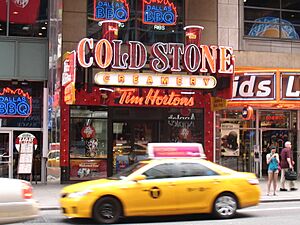
In February 2009, Kahala, the company that owns Cold Stone Creamery, announced a deal with Tim Hortons. They planned to open up to 100 stores in the United States that would sell both brands. The most famous shared store opened in August 2009 when Tim Hortons moved into three Cold Stone Creamery locations in New York City, including one in Times Square.
In June 2009, Cold Stone Creamery started testing the Canadian market by opening shared locations with Tim Hortons in Ontario. However, in February 2014, Tim Hortons announced they would remove Cold Stone Creamery from all its Canadian restaurants. Tim Hortons would keep its locations in the United States.
Military Partnerships
Tim Hortons has locations on at least seven Canadian Forces Bases. In March 2006, Tim Hortons announced it would open a location at the Canadian Forces base in Kandahar, Afghanistan. This new Kandahar location opened on July 1, 2006. It was in a 40-foot trailer on the military base. The Canadian government helped pay for the operation of this outlet. The Kandahar Tim Hortons closed on November 29, 2011, after serving millions of cups of coffee and donuts over five years.
The first Tim Hortons outlet at a U.S. military base opened in 2009 at Fort Knox. By November 2011, Tim Hortons had five outlets on four U.S. military bases.
Roll Up to Win Campaign
Every February, Tim Hortons holds a special contest called "Roll Up to Win." In the past, customers would unroll the rim of their paper cups to see if they won prizes like cars, televisions, or free food. The idea for the contest started in 1985. The first "Roll Up the Rim to Win" campaign was held in 1986, and the biggest prize was a snack box of Timbits.
The contest is so popular that someone even invented a device called the "Rimroller" to help unroll the rims!
The contest has had some issues, like people trying to steal unrolled cups. In March 2006, two families argued over a car prize after their daughters found a winning cup in a garbage bin. Tim Hortons eventually decided to give the prize to the younger girl who first found the cup. The company has also faced concerns about the extra litter created by the promotion.
In 2017, a special "Roll Up the Rim" promotion was held in July to celebrate Canada's 150th birthday. In 2018, Tim Hortons started adding digital parts to the promotion through its mobile app.
In 2020, because of the COVID-19 pandemic, Tim Hortons announced they would stop giving out physical cups for the promotion. This was to prevent the spread of the virus. The contest was then done only through the app. These changes from 2020 remained in use through 2024, and the promotion was renamed "Roll Up to Win." Tim Hortons also announced that every digital entry would win at least some Tims Rewards points. In February 2025, Tim Hortons announced that physical cups would return to the promotion for a limited time, alongside digital entries.
Community Involvement
Tim Hortons supports many community programs. These include Free Skating, Free Swimming, and the Smile Cookie program.
The company also promotes itself through the Tim Horton Children's Foundation. This foundation was started by Ron Joyce. It helps thousands of children from Canada and the United States who might not have many opportunities. It sends them to one of six special summer camps.
The foundation's biggest fundraiser is Camp Day. This event is held every year on the Wednesday of the first full week in June. All the money from coffee sales at most Tim Hortons locations on that day, plus money from other activities, goes to the foundation.
Tim Hortons became a sponsor of Hockey Canada in December 2019. This includes sponsoring the Centennial Cup, which is the national junior "A" ice hockey championship. They are also a major sponsor of Canada's national ice hockey teams.
See also
 In Spanish: Tim Hortons para niños
In Spanish: Tim Hortons para niños


